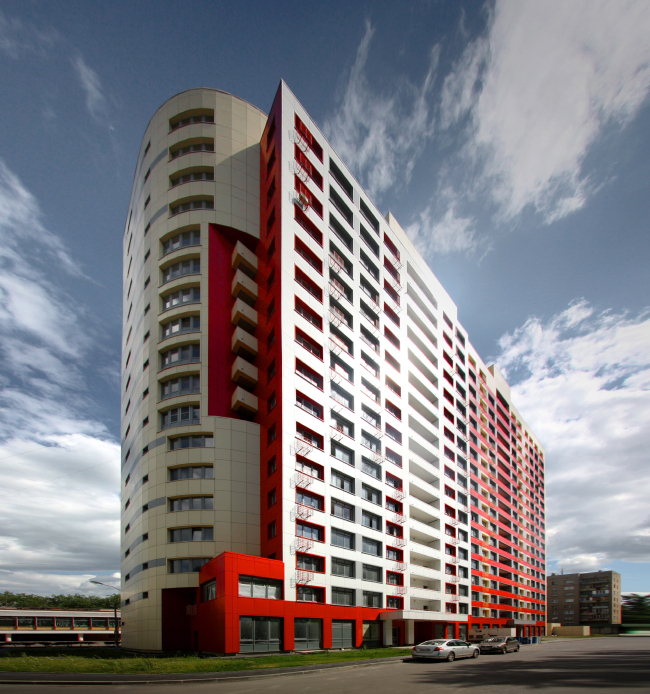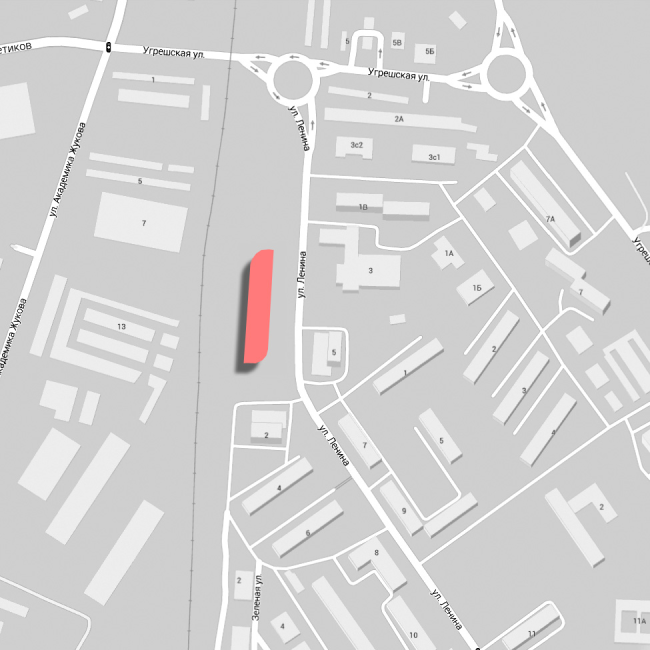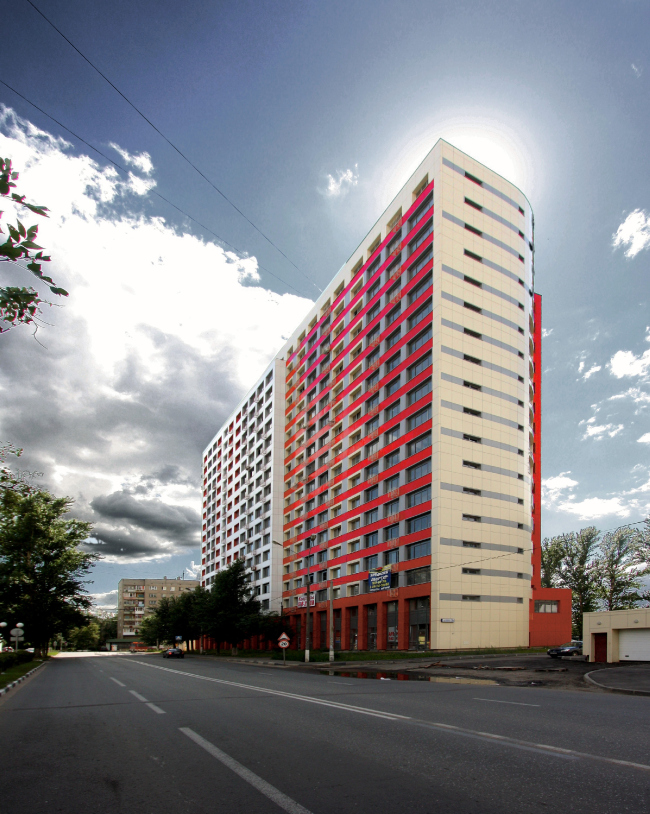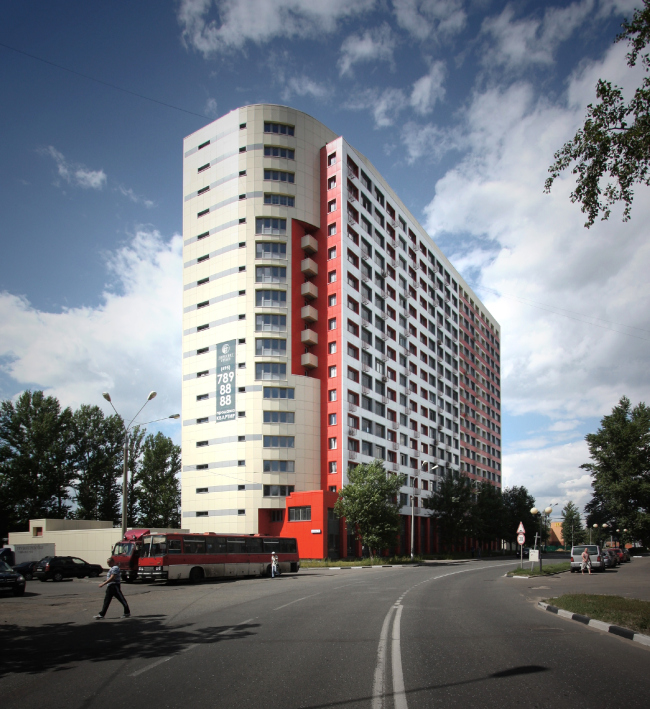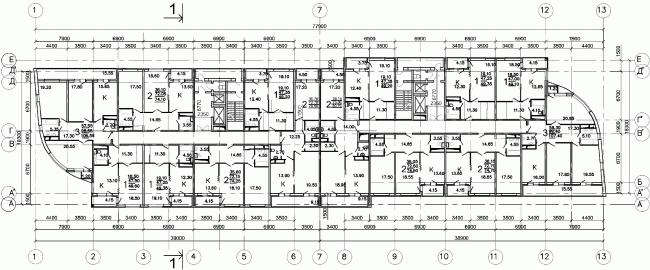|
The Asadov Bureau has built in the city of Dzerzhinsky one of the most up-to-date red-and-white houses, in the vein of neo-constructivism.
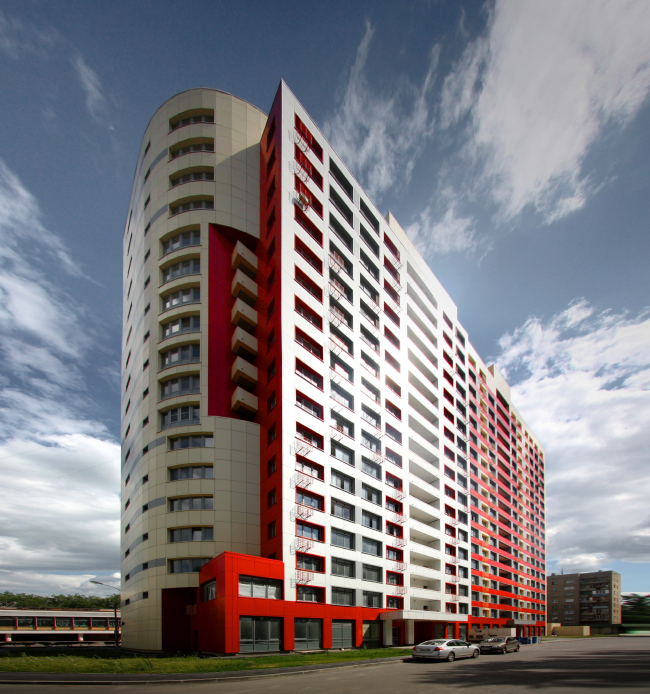
Residential complex in the city of Dzerzhinsky © Asadov Architectural Bureau
The slab of this residential building stretches between the Lenin Street and the railroad line, amidst the trees, garages, and the high-rises of the northern part of the Moscow area's city of Dzerzhinsky. This spot is a kilometer and a half away from the Moscow Ring Road, and two kilometers or but a half-hour's walk away from the Nikolo-Ugreshsky Monastery, the ancient but built anew centerpiece of this area. Hence, the new residential complex got a name of "Ugreshsky".

Residential complex in the city of Dzerzhinsky © Asadov Architectural Bureau
The complex, actually, consists of but one building: two floors of the 190-stall underground parking garage, a bank, cafés and shops in the ground floor, seventeen residential floors on top, and the business-class apartments consulting of one to three rooms. It was built in 2012, and "became an accent in the cityscape for its size, if for anything - Andrew Asadov shares - this is why we wanted to make it as clear-cut and structural as possible. Ultimately, from the composition standpoint, what we got was a "flip-flopper" consisting of two sections with semicircular bay windows on its side walls. The building's silhouette marks the break of the city's main street. And as for the details, they were developed as the continuation of the main idea that highlights the two-section structure and the semicircular accents on the corners". "Flip-flopper" - because the volume of the house is built according to the principle that was so much loved by the architects of the avant-garde of the 1920's and then of the neo-constructivism of the 2000's, namely that of the symmetry of rotation: one of its parts (i.e. sections) reflects the other - not in the mirror fashion but as if it was rotated on a pivot. Now, let us imagine a small paper knife with a curved blade whose one pointed end is turned exactly south and the other exactly north, like the compass needle that was spinning but a moment ago and now has finally stopped.
The imaginary movement left its trace: the parabolic outlines of the pointed "noses" that look like fan blades, point in the direction if the arrested motion (like in the solar sign) that is picked up, on turn, by the slabs of the facade extrusions. There are two such extrusions: the longer one on the side of the Lenin Street and the shorter one on the side of the yard - they also fall in with the rotation symmetry and are supported by the balcony ledges that are there at the very edges of the slab, also corresponding to the "noses" and also symmetric.
The ledges correspond to the joints between the sections, otherwise all but invisible, also because of the fact that the slabs on the east and west facades are slightly juxtaposed, as if striving to avoid any strict division of the building into the northern and southern parts.
The alternating of the slabs of the extrusions is accentuated by the color: the outstanding parts of the facades are white with red side surfaces which crests a graphic impression of them "stepping forward". The neighboring surfaces that made a step back are conversely stitched with energetic red horizontals against the background of the gray vertical partitions. The general impression is that of the building being "stripped" of its "skin" and laying bare the striped structure of its "insides", almost ecorche. One could even (subject to prior agreement, of course), read this form in this way: the neat white aluminum contemporary house got chipped off and, from underneath the top layer, showed up the avant-garde core of the entire contemporary architecture. Or in this way: this city is the spawn of the commune of the homeless children "named after Felix Dzerzhinsky", a "commune" city, but after the WW2 its center got some quite respectable and Stalin-architecture buildings - they lined up closer to the city center along the Lenin Street. The facades of the "Ugreshsky" house serve as an almost literal demonstration of this "healing" process from the avant-garde homeless to the cozy domestic. All of this, of course, nothing more than suppositions - but, if they appear, then the building is suggestive of them, then it is not empty and not devoid of interesting ideas.

Residential complex in the city of Dzerzhinsky © Asadov Architectural Bureau

Residential complex in the city of Dzerzhinsky © Asadov Architectural Bureau

Residential complex in the city of Dzerzhinsky © Asadov Architectural Bureau
At the same time, the building's geometry remains pure and simple, though supported, as the architect confesses by numerous details. The priority of the horizontals is enhanced by the gray strokes on the side-wall "blades" whose array, though, is broken by an unexpected insert, or, rather, a cutaway: the cutaway sports a bright-red niche with six balconies; it willfully moves aside the array of the windows, syncopating their rhythm. This is the accent meant to be viewable from the main vantage point, the corner that opens up from the turn of the Lenin Street pointed in the direction of the monastery (maybe this is the proverbial cryptic "red corner", the meaningful play of the traditional avant-garde is doubtlessly present here, even though in a very unobtrusive form). Other subtleties: red window frames against the white surface, gray rectangles between the windows that, again, support the horizontal, the alternating stanzas and windows, the lacework of the small grilled balconies, scattered all over the facade rather irregularly, to name but a few.
This building can be quite safely referred to the so-popular-in-the-2000's (and even in the late 1990's) trend of neo-constructivism. Proceeding from the true, even if a bit nostalgic, statement belief that "avant-garde is our all", the architects tried to make its principles and techniques come alive, see the world through its eyes, at times suffering from the contradiction consisting in replicating the motifs of that movement that allowed of no replication in the first place. But then again, neo-constructivism has remained one of the honest and sincere attempts to turn back to one's roots, which bore its, though a bit nostalgic, fruit both on a small and grand scale. One should think that it would be fair to recognize the building in question as coming a bit late in the day but still a mature example of neo-constructivism: the symmetry of rotation, the pointed noses, the subtle stereometric play that nearly fits within the simple geometry, and especially the "billboard" red-and-white colors are the sure signs of the architecture of the 1920's. The deliberate breaks on the rhythm that are meant to lighten up the form, the thin finish, and the alien-to-collectivism little balconies (as well as the 17-floor scale and the building and finishing materials: the monolith framework and the aluminum panels) - belong to our day and age and the prefix "neo".
The building has yet another pleasant quality to it that already distinguishes it by today's standards of the 2010's, and this is a great quality: it is just a house. After 2010, architecture got diverted from the houses per se, and shifted its main focus predominantly on the macro scale: neighborhoods, settlements, and entire neighborhoods, and the micro scale: improvements, parks, and landscaping. These are all very important areas but one cannot help but notice that the diversity of the urban environment is created not only by the different paving patterns but also by the buildings, the thought-out concepts of their volumes, as well as their details and colors. Once the architects start neglecting them, the houses fall back into the realm of typical construction, cheap and all-penetrating as it is. And one's eyes are so pleased when they see a well thought-out "architectural" house. Just a house.

Residential complex in the city of Dzerzhinsky © Asadov Architectural Bureau
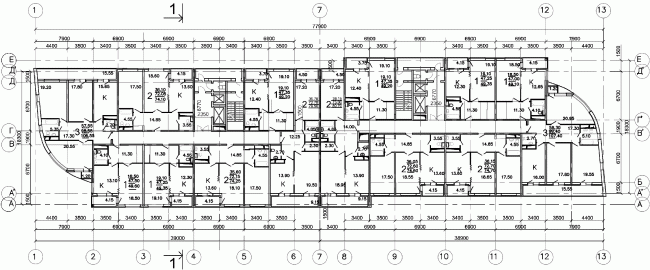
Residential complex in the city of Dzerzhinsky © Asadov Architectural Bureau
None
None
None
None
None
None
None
|







